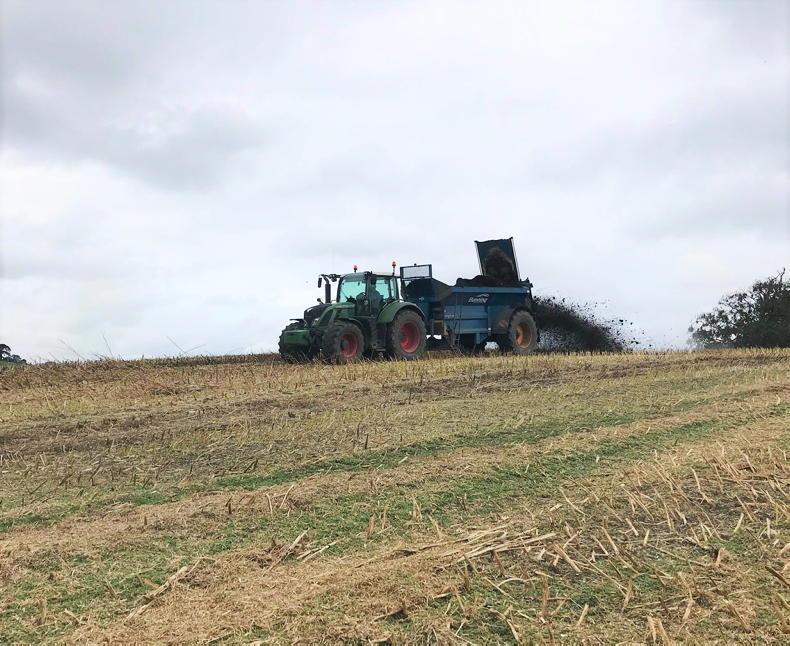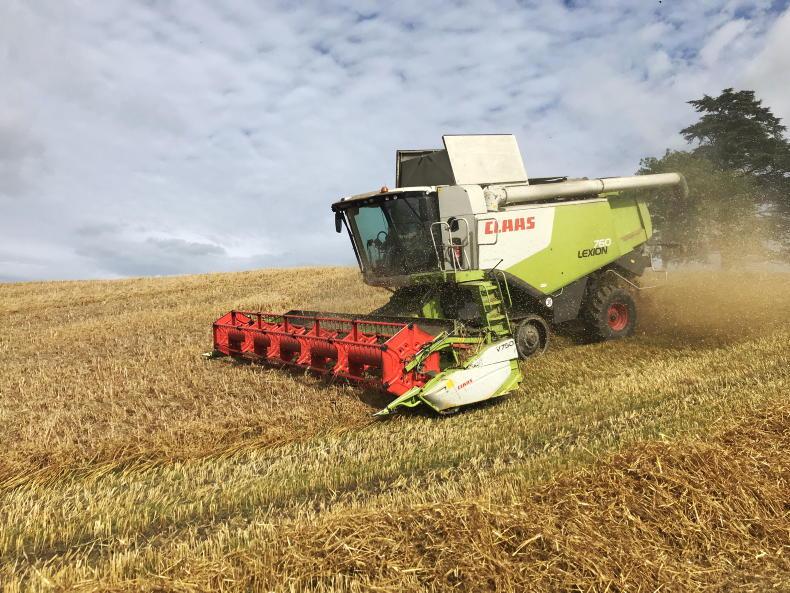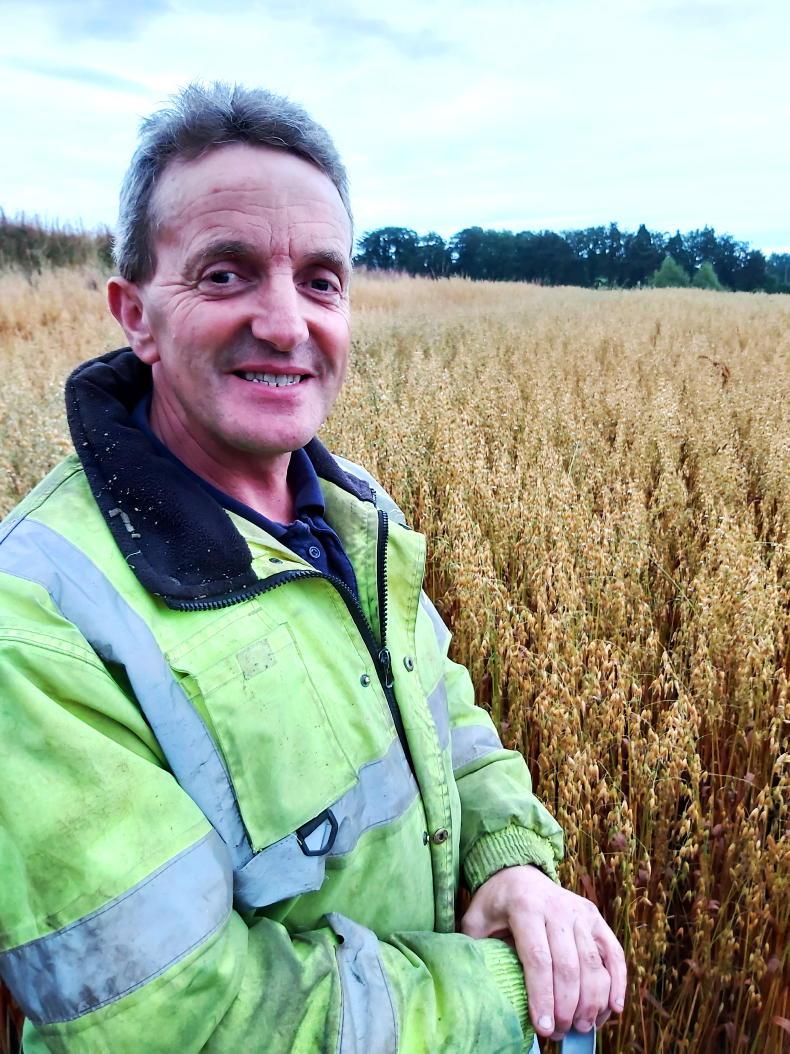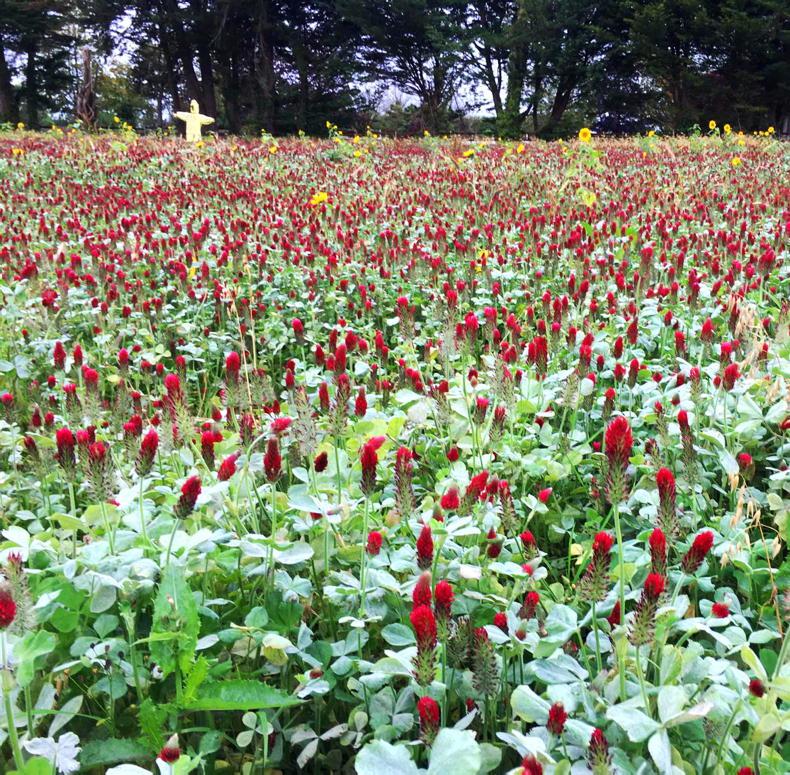The Irish Tillage and Land Use Winter Conference covered the key topics of the moment, including fertiliser prices, CAP and sustainability.
Attendees of the conference also heard from three tillage farmers who shared their stories of what it means to them to be sustainable.
This article profiles those three farmers.
Simon Best –
The five pillars of a sustainable farm

Simon spreading compost on his farm.
Former From the Tramlines farmer and recently crowned UK Arable Farmer of the Year Simon Best farms over 1,000ac in Poyntzpass, Co Armagh, in partnership with his parents and brother Rory.
As far as Simon is concerned, the manner in which he farms has always been sustainable as he has been able to marry five key “pillars of sustainability” into his farm business model. These are:
1 Quality production and short integrated supply chains: Simon has pride in his business model’s short, integrated supply chain. His oats are grown for Speedy Cook, located less than five miles away. His wheat, barley and beans are used locally for feed and his oilseed rape is used by Moy Park.
2 Resource efficiency: In every aspect of his business he tries to maximise efficiency. For example, by using his sprayer to apply liquid fertiliser, he doesn’t have to own a fertiliser spreader and can evenly cover a tramline width of 36m.
3 Soil improvement: 12 years ago he started a green waste recycling business to produce compost to spread on the land which has been central to improving his soil organic matter levels and improving soil quality in his plough-based system.
4 Environmental enhancement and community engagement: His farm is LEAF (Linking Environment and Farming) accredited, meaning he adheres to a higher level of environmental stewardship when farming and he also holds open days for the community to visit his farm. He wants to show the benefits of these schemes.
5 Continuous development and innovation: Finally, the farm is employed in several projects including one aiming to assess a baseline for carbon sequestration levels on his farm.

Simon best harvesting oilseed rape.
James Ashmore –
A journey to direct drilling

James Ashmore.
When James returned to farm full-time on his mixed tillage and beef farm in Mullamast, Kildare, his journey to direct drilling began and saw the significant evolution of his farming system.
James returned to a traditional plough-based mixed tillage and livestock farm in 2014. In 2016 he started growing hay as he wanted to include more grass into the rotation after experiencing severe problems with wild oats in a gluten-free oat crop. He thought the grass could help with this problem while also improving soil structure.
In 2017 he started to introduce cover crops into the mix as he wanted to grow extra fodder for sheep, helping to better utilise the ground and further improve soil structure.
Drought
In 2018, following the drought, he decided to redesign his rotation. His new nine-year rotation included grass, cereals, peas, maize and cover crops to better suit his farm.
However, in autumn 2019, after a difficult maize harvest and seeing bad machinery damage to fields and large amounts of plastic left over, he decided to drop maize grown under plastic from his rotation.
After becoming disillusioned with topsoil blowing away and other soil-damaging practices, he decided to start moving away from cultivations and in 2020 he invested in a Duncan direct drill. Over the next two years, James began experimenting with direct drilling in conjunction with other measures such as composting, straw chopping, cover crops, sowing directly into covers, pea trials, growing maize plastic-free and using no insecticides.
As he continues with the development of his direct drilling system he has many more trials planned, including further composting, companion cropping, biological treatments, multispecies swards and further pesticide and fertiliser reduction.
However, James said the drill is only one piece of the puzzle and the system can only work with a combination of the above farming practices.
Tom Fouhy –
Fantastic scope for organic growth

Tom Fouhy.
One thing which was crystal clear from Cork farmer Tom Fouhy’s presentation was that organic tillage farming is complex and requires knowledge, planning and dedication.
Tom is a part-time organic tillage farmer from near Mallow in Co Cork. He currently farms 110ac running a minimum tillage system.
Tom says that organic farming was attractive to him due to his farm size, the flexibility it offered and the market opportunities that began to appear at the time.
Crops
Tom grows a diverse range of crops, many of which he learned how to grow after years of trial and error. His biggest crop is oats grown for Flahavan’s. He also grows wheat for feed and milling and has trialled triticale and rye, both both of grew well.

Tom Fouhy grows a diverse range of crops.
He grows multiple legumes including beans, peas and lupins and tries to integrate these as much as possible into his rotation to help maintain and build soil fertility. He also grows oilseed rape as well as linseed and has grown Camelina in the past.
Tom is also trialling hemp this year and has grown spelt, Emmer and Einkorn, as well as sunflowers and buckwheat in the past.
Markets
Tom says when deciding what to grow he generally starts by looking at the end market and working backwards. His rotation is complex and he has to carefully look at crop choices and agronomy to see if it fits in with his soil fertility maintenance and weed control programme.
Most of his cereals are sold directly to farms and demand is good. His oilseeds and pulses are sold to artisan food producers and some have been exported to the UK. Tom thinks there is fantastic scope for growth in many of these markets.
The Irish Tillage and Land Use Winter Conference covered the key topics of the moment, including fertiliser prices, CAP and sustainability.
Attendees of the conference also heard from three tillage farmers who shared their stories of what it means to them to be sustainable.
This article profiles those three farmers.
Simon Best –
The five pillars of a sustainable farm

Simon spreading compost on his farm.
Former From the Tramlines farmer and recently crowned UK Arable Farmer of the Year Simon Best farms over 1,000ac in Poyntzpass, Co Armagh, in partnership with his parents and brother Rory.
As far as Simon is concerned, the manner in which he farms has always been sustainable as he has been able to marry five key “pillars of sustainability” into his farm business model. These are:
1 Quality production and short integrated supply chains: Simon has pride in his business model’s short, integrated supply chain. His oats are grown for Speedy Cook, located less than five miles away. His wheat, barley and beans are used locally for feed and his oilseed rape is used by Moy Park.
2 Resource efficiency: In every aspect of his business he tries to maximise efficiency. For example, by using his sprayer to apply liquid fertiliser, he doesn’t have to own a fertiliser spreader and can evenly cover a tramline width of 36m.
3 Soil improvement: 12 years ago he started a green waste recycling business to produce compost to spread on the land which has been central to improving his soil organic matter levels and improving soil quality in his plough-based system.
4 Environmental enhancement and community engagement: His farm is LEAF (Linking Environment and Farming) accredited, meaning he adheres to a higher level of environmental stewardship when farming and he also holds open days for the community to visit his farm. He wants to show the benefits of these schemes.
5 Continuous development and innovation: Finally, the farm is employed in several projects including one aiming to assess a baseline for carbon sequestration levels on his farm.

Simon best harvesting oilseed rape.
James Ashmore –
A journey to direct drilling

James Ashmore.
When James returned to farm full-time on his mixed tillage and beef farm in Mullamast, Kildare, his journey to direct drilling began and saw the significant evolution of his farming system.
James returned to a traditional plough-based mixed tillage and livestock farm in 2014. In 2016 he started growing hay as he wanted to include more grass into the rotation after experiencing severe problems with wild oats in a gluten-free oat crop. He thought the grass could help with this problem while also improving soil structure.
In 2017 he started to introduce cover crops into the mix as he wanted to grow extra fodder for sheep, helping to better utilise the ground and further improve soil structure.
Drought
In 2018, following the drought, he decided to redesign his rotation. His new nine-year rotation included grass, cereals, peas, maize and cover crops to better suit his farm.
However, in autumn 2019, after a difficult maize harvest and seeing bad machinery damage to fields and large amounts of plastic left over, he decided to drop maize grown under plastic from his rotation.
After becoming disillusioned with topsoil blowing away and other soil-damaging practices, he decided to start moving away from cultivations and in 2020 he invested in a Duncan direct drill. Over the next two years, James began experimenting with direct drilling in conjunction with other measures such as composting, straw chopping, cover crops, sowing directly into covers, pea trials, growing maize plastic-free and using no insecticides.
As he continues with the development of his direct drilling system he has many more trials planned, including further composting, companion cropping, biological treatments, multispecies swards and further pesticide and fertiliser reduction.
However, James said the drill is only one piece of the puzzle and the system can only work with a combination of the above farming practices.
Tom Fouhy –
Fantastic scope for organic growth

Tom Fouhy.
One thing which was crystal clear from Cork farmer Tom Fouhy’s presentation was that organic tillage farming is complex and requires knowledge, planning and dedication.
Tom is a part-time organic tillage farmer from near Mallow in Co Cork. He currently farms 110ac running a minimum tillage system.
Tom says that organic farming was attractive to him due to his farm size, the flexibility it offered and the market opportunities that began to appear at the time.
Crops
Tom grows a diverse range of crops, many of which he learned how to grow after years of trial and error. His biggest crop is oats grown for Flahavan’s. He also grows wheat for feed and milling and has trialled triticale and rye, both both of grew well.

Tom Fouhy grows a diverse range of crops.
He grows multiple legumes including beans, peas and lupins and tries to integrate these as much as possible into his rotation to help maintain and build soil fertility. He also grows oilseed rape as well as linseed and has grown Camelina in the past.
Tom is also trialling hemp this year and has grown spelt, Emmer and Einkorn, as well as sunflowers and buckwheat in the past.
Markets
Tom says when deciding what to grow he generally starts by looking at the end market and working backwards. His rotation is complex and he has to carefully look at crop choices and agronomy to see if it fits in with his soil fertility maintenance and weed control programme.
Most of his cereals are sold directly to farms and demand is good. His oilseeds and pulses are sold to artisan food producers and some have been exported to the UK. Tom thinks there is fantastic scope for growth in many of these markets.











 This is a subscriber-only article
This is a subscriber-only article











SHARING OPTIONS: